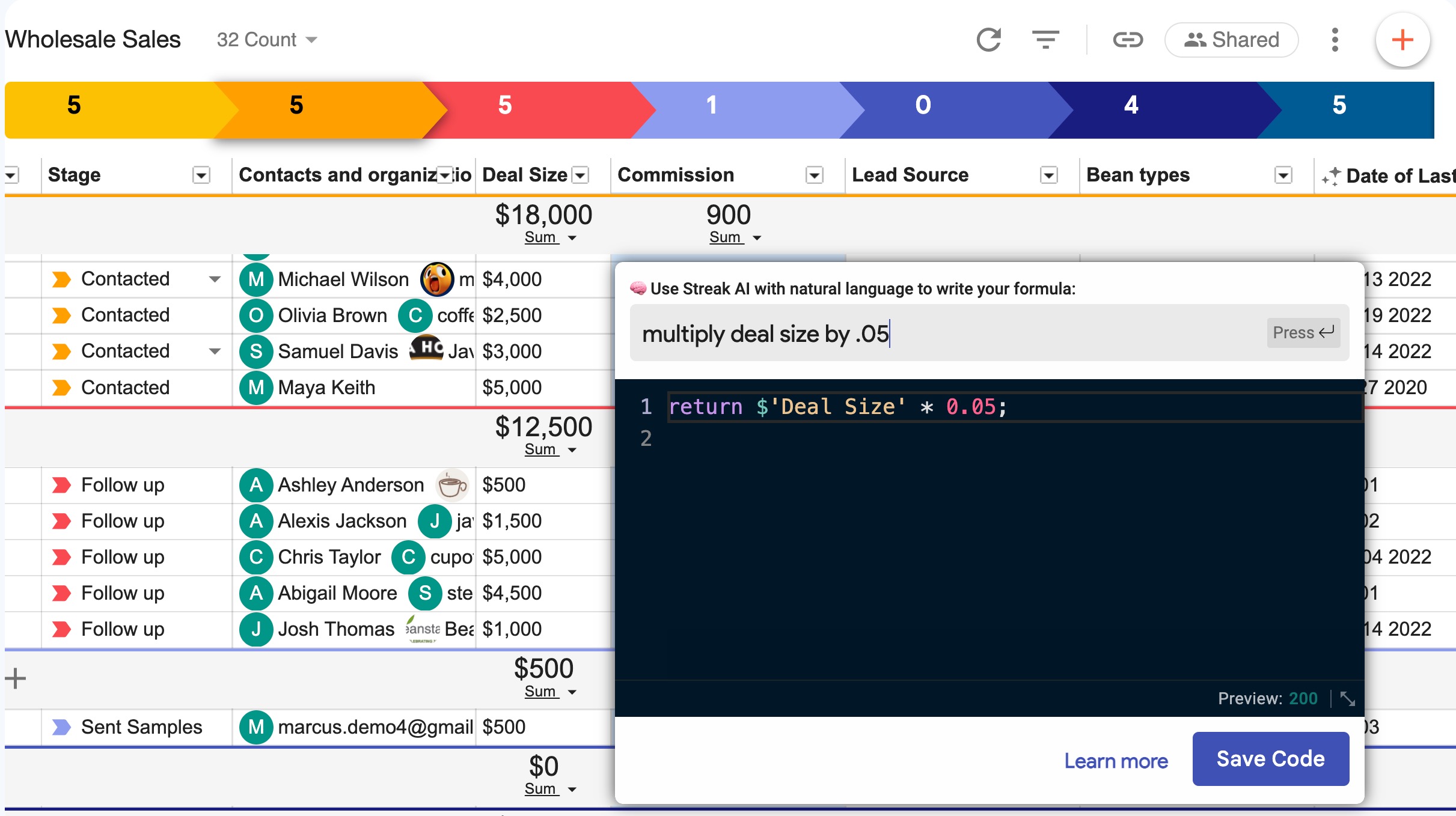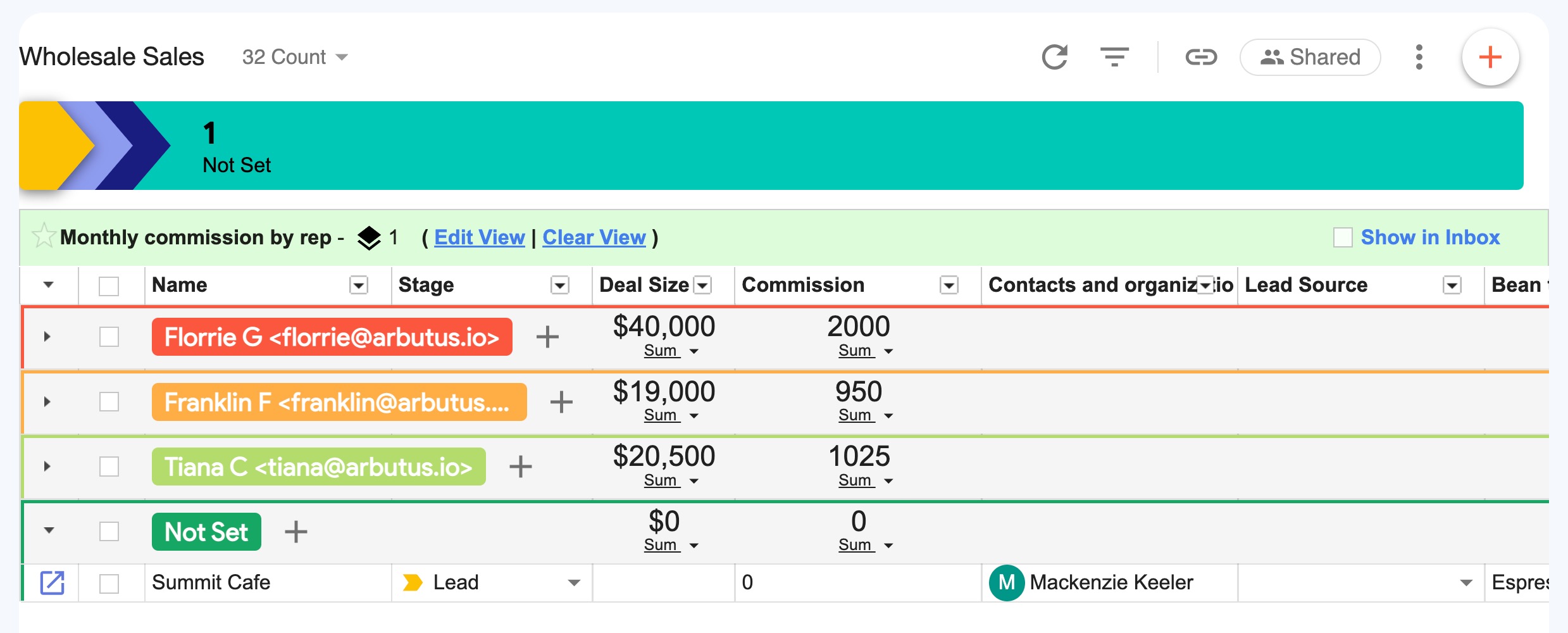Opening now...
How to determine and calculate your sales commission structure
In addition to receiving a base salary, most sales representatives also receive a commission on each sale they make. This pay structure offers sales reps a financial incentive for excellent performance.
However, commission structures can also be a bit confusing, especially if you’re new to working in sales. Finding the right commission structure for a new sales team is also a major challenge.
In this article, we’ll dive into what a sales commission is, how it works, and why teams use it. We’ll also look at ways to structure and calculate sales commissions for your team.
<a href="#what-is-sales-commission" class="anchor-link">What is sales commission?</a>
<a href="#why-do-sales-teams-use-a-commission-structure" class="anchor-link">Why do sales teams use a commission structure?</a>
<a href="#how-do-sales-teams-structure-commissions" class="anchor-link">How do sales teams structure commissions?</a>
<a href="#what-to-consider-when-choosing-a-commission-structure" class="anchor-link">What to consider when choosing a commission structure</a>
<a href="#how-to-calculate-and-manage-sales-commissions" class="anchor-link">How to calculate and manage sales commissions</a>
<div class="anchor-wrapper"><div id="what-is-sales-commission" class="anchor-target"></div></div>
What is sales commission?
A sales commission is a form of monetary compensation based on how many sales an employee makes.
Most sales reps receive a base salary plus some form of commission. Standard commission structures and amounts vary by industry. For example, they might receive 5% of the amount of each sale on top of their fixed salary.
<div class="anchor-wrapper"><div id="why-do-sales-teams-use-a-commission-structure" class="anchor-target"></div></div>
Why do sales teams use a commission structure?
Sales teams use a commission structure to keep their employees motivated. Tying compensation directly to performance incentivizes your team to close as many sales as possible. It also encourages them to continue working to improve their skills.
Additionally, commission structures give employees a way to share in your organization’s success. When your company is doing well financially and your sales team has contributed to that success, they get to share in that success directly.
<div class="anchor-wrapper"><div id="how-do-sales-teams-structure-commissions" class="anchor-target"></div></div>
How do sales teams structure commissions?
There are a variety of ways to structure sales commissions. The right commission approach for your team will depend on your industry as well as the price point of the products you sell.
There are various types of commission structures to choose from.
Base pay + percentage of sale
This is the most common sales commission structure. Team members receive a base salary plus a percentage of every sale they make.
This ensures that salespeople still receive a paycheck even when sales are slow. It also compensates them for tasks they complete when they aren’t making sales.
Straight commission
A straight commission model doesn’t include a base salary - team members are paid entirely from their sales commissions.
Many sales professionals avoid straight commission models because they are financially risky.
Tiered commission
With this model, the commission rate increases as sales increase, rewarding high-performing team members even further.
For example, salespeople might receive 3% on all sales up to $50,000, 5% on sales from $50,000 to $100,000, and 7% on sales above $100,000.
Cash draw commission
This commission structure works as an advance and helps new sales professionals stay afloat until they make their first sales. The company provides a cash draw of a certain amount as an advance on their commission. This can be a sign of good faith from the employer and a way to the employee as they ramp up in their sales role.
Some cash draw agreements are arranged so the employee makes up the difference in the cash draw amount and the actual commissions they earned. For example, if the employee received $1,000 as their cash draw and made $3,000 in commissions, they’d receive $2,000 of those commissions on their next paycheck. In some cases, employees may be required to repay their advances if they don’t meet that amount in commissions. For example, if the employee only made $500 in commissions, they’d have to repay the $500 of the advance by a certain date.
Gross margin commission
This approach ties commission to profitability and encourages team members to upsell. With this model, team members are paid a percentage of the profit margin of each sale, rather than a percentage of the sale amount itself.
Team commission
Some organizations pay commissions based on team performance rather than individual performance. This is a good approach for sales teams that work together closely and share responsibilities.
SPIFs
A SPIF (Sales Performance Incentive Fund), is a type of sales commission structure that offers additional incentives to sales representatives for achieving specific sales targets or objectives within a set timeframe.
These incentives can include bonuses, cash rewards, prizes, or other perks. SPIFs are often used to motivate salespeople to focus on specific products, services, or sales objectives that are critical to the success of the organization.
For example, for each annual plan that a sales rep sells in the month of March, they’ll receive a 20% bonus on their quota for those deals.
SPIFs can help boost morale and drive sales, but they must be carefully designed and implemented to ensure that they are fair, transparent, and aligned with the overall goals of the company.
<div class="anchor-wrapper"><div id="what-to-consider-when-choosing-a-commission-structure" class="anchor-target"></div></div>
What to consider when choosing a commission structure
When choosing a sales commission structure for your organization, you’ll need to take a holistic look at your sales team to find a structure that best meets your needs. There are a few things to consider when doing so.
Sales goals
Commission should incentivize your sales reps to achieve certain goals. Start with a clear understanding of what your company’s sales goals are and how each rep can contribute to those.
For example, do you have a certain goal for monthly recurring revenue (MRR), or are you interested in upselling add-on or high-margin products? Different commission structures will help incentivize different goals and make sure your sales reps are aligned with your company’s objectives.
Budget
Your commission structure should align with your budget to keep costs reasonable, but you’ll also need to pay enough in commissions to incentivize good performance and minimize turnover.
A good place to start is by looking at your company’s price point and sales volume. Do you sell a high volume of low- to mid-ticket items, or does your revenue come from a smaller number of big sales? If it’s common to go weeks or months without making a sale, it’s important to offer a base salary to keep your employees afloat during slow periods.
Industry and regional trends
It’s also important to consider commission trends in your industry and region. Look at salary and commission data for companies similar to yours to get an idea of what your salespeople will expect. If your commission rates don’t keep pace with the rest of your industry, you’ll have a difficult time retaining top talent.
Sales commission structures shouldn’t be set in stone. Check in regularly with your team members to get feedback, and don’t be afraid to adjust commissions as needed. Keep in mind that some team members may benefit from different commission rates or structures depending on their role and level of seniority.
<div class="anchor-wrapper"><div id="how-to-calculate-and-manage-sales-commissions" class="anchor-target"></div></div>
How to calculate and manage sales commissions
Deciding how to structure commission is the first step, but calculating and paying out sales commission is an ongoing process.
Fortunately, tools like Streak can help make it easier for both sales reps and sales managers.
Calculate commissions on sales
Once you’ve determined which commission structure you want to use, you should be able to calculate sales commissions with a mathematical formula.
Commission = deal size * 0.05
For example, if you have a base pay and percentage of sale commission structure at 5% commission on total sales and a sales rep sold $10,000 during the pay period, they’d receive $500 in commissions on top of their base salary.
It’s a good idea to run calculations for various scenarios, like if a rep comes in above or below the quota, to make sure you’re comfortable with each one.
Tools like Streak can help you keep track of your team’s deals and sales volume so you can automatically calculate commission on each deal. By tracking deal size in your pipelines and adding formula columns, you can calculate commissions automatically for each deal.

This allows each rep to see exactly how much they’ll make on each sale before it closes, which increases transparency and keeps your team members motivated.
As a sales manager, you can use saved views in your pipelines to see the total commission for deals closing each month, by sales rep.

Paying out commissions
Now that you know how to structure and calculate your sales commission, it’s time to reward your reps for their work by paying out sales commission.
Many organizations pay commissions based on sales cycles, which means that employees receive their commissions monthly or quarterly. However, some organizations that have larger deal sizes and longer lead times will pay commission based on when a deal closes.
Some states, such as California, have laws that require organizations to pay employees’ commissions within a certain time frame. You’ll want to keep these legal requirements in mind
when determining your organization’s pay schedule. It’s also important to remember that most sales professionals prefer frequent paychecks.
Create a sales commission structure for your specific needs
While sales commissions are the norm in most organizations, you’ll want to customize your commission structure and schedule to support your organization’s needs. There’s no one-size-fits-all solution.
If you’re creating a sales commission for the first time or reevaluating an existing one, take some time to think through your goals as an organization and sales team.
Try Streak for free to start tracking deals in your pipelines.
Subscribe to our blog
Stay in the loop with Streak’s latest features and insights.





.webp)


